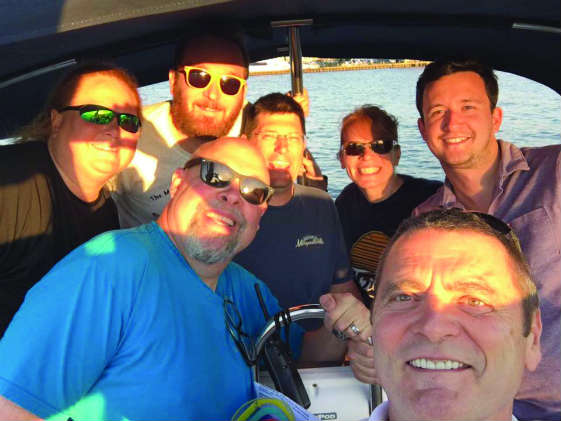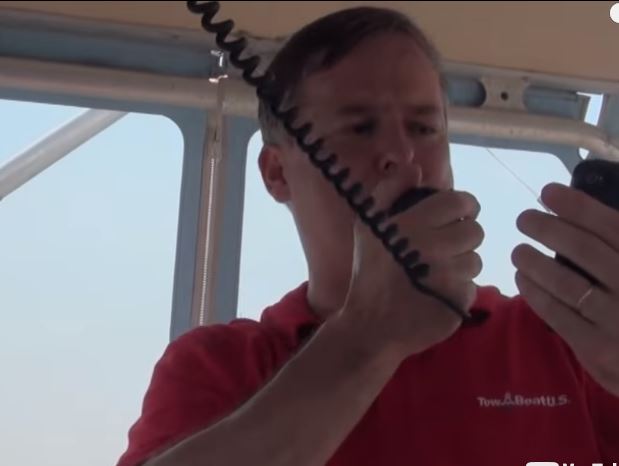Getting Help from Your Crew Safety Series Part 2: Here’s a novel suggestion on how to handle boating emergencies more effectively: don’t get stuck having to do it alone. Train your crew in some of the basics over the next few months, so they’re ready if a mishap occurs.
At first blush, that doesn’t sound very realistic. Nobody wants to go through a long list of emergency procedures before shoving off. Depending on their boating experience, most people you take out for a day trip either know what to do or they don’t, and you can’t change that on the spot. It takes time and practice to become truly proficient in such skills.
But if you concentrate on your regular crew—family members or boating buddies who go out with you regularly—you can do the job gradually and painlessly. Start with a bit of hands-on training and occasional practice drills each time you go out, as little as 10 minutes out of your boating time. And if you play it right, both you and your crew actually may enjoy it.
The benefits almost certainly will be worth the effort. Even if only one other person onboard has been trained and has practiced some emergency procedures, it will ease your job as skipper, enable you to cope with mishaps more effectively, and increase your safety level significantly. And you don’t have to start your own seamanship school to do it.
Having a trained crewmember onboard also will help solve the dilemma that your boat mates would face if something happened to you while you were on the water. Suppose you cracked your knee on a cleat or fell overboard? Who would come to your aid?
Who would call the Coast Guard if it were necessary? Who would get the boat back home?
Here are some of the basics you can teach your crew and practice easily when you’re under way.
- How to put on a lifejacket-and to help others do it, too. Yes, everyone on your boat ought to be wearing a lifejacket, but if you’re lax about that, the least you can do is make sure someone is there to help them if you run into trouble. When you’re really in a spot, taking time to help others don their lifejackets can impede your own ability to respond to the emergency.
- How to call the Coast Guard. Operating a VHF-FM marine radio isn’t that difficult, but it’s more complicated than using a telephone. Show crewmembers how to turn the radio on and off, select the proper channel, key the microphone, speak slowly and clearly, signal a distress call, and provide the information that first responders will need to come to your rescue. Some boaters post a placard near their radio that provides these instructions and includes a short description of their boat that the crewmember or guest can pass along to the Coast Guard. This is especially important if you, the skipper, are incapacitated. Practice using a microphone without taking up the airwaves. Use an inexpensive, short-range walkie-talkie instead.
- How to use a fire extinguisher. That may seem obvious, but it isn’t to a newcomer. Show your crew how to get the extinguisher off its bracket, how to operate it, and how to point the stream at the base of the fire rather than at the flames. Emphasize that the spray will last for only a few seconds. (Just go through the motions. Don’t actually trigger the extinguisher.)
- How to use your distress signals. Show your crew where you keep your flares, air-horn, and other devices, and how to use them. Caution them to be sure they’re on the leeward side of the boat and away from the fuel tanks when they light off a flare, so they don’t cause a fire themselves. Demonstrate the technique of waving your arms to warn others you’re in distress.
- How to shut off the engine and electrical power on your boat. Operating the shutoff switches isn’t easy on every boat, but it can be crucial, especially in case of a fire or a mechanical failure in a crowded marina. Practice this one at the dock. Walk your crewmembers through the procedure and then have each of them try it. Repeat it to keep them in practice.
- What to do when someone falls overboard. Ideally, you need to take the helm while one of your crewmembers keeps pointing at the person in the water so you don’t lose sight of him or her. Someone also should throw out a floatation device—both at the spot where the person fell overboard and when you finally reach the victim to help keep him or her afloat. Figure out in advance how to get a victim back onto your boat and walk your crew through the procedure. Pulling someone back onboard can be a serious challenge if you don’t have a boarding ladder, especially if the victim is injured. Search online for gear that may be suitable for your boat. Protect the victim from your propeller; kill your engine as he or she boards.
How do you train your crew?
Start with yourself. Do you know your stuff well enough to show others? If not, brush up. Take courses or hire a private instructor to help you improve your own boating skills. (The Chesapeake Area Professional Captains Association is one source.) You’ll learn a lot more if you acquire enough knowledge and experience to teach your crew.
Get your crew involved in making pre-underway checks. Take them through what you do to check your fuel, inspect your bilges, sniff for gasoline fumes, operate your ventilation system, make sure your fire extinguishers are properly charged, and other such tasks. Doing this will help show them where such equipment is located and help familiarize them with how it works.
Provide them with hands-on training by walking them through the list of skills offered earlier in this article, and ask each of your crewmembers to demonstrate what you’ve just shown. Then, while you’re under way, find a place that’s clear of boat traffic and conduct a drill. As soon as it’s over, ask your crew to give you a critique of what went wrong.
Note: Be sure to let them do it, even if they do it wrong. Making mistakes is a good way to learn. And remember to be patient. Womanship, a onetime sailing school for women, had a great slogan—“Nobody Yells.” It works for teaching men as well. Everybody learns more effectively when the teacher is patient.
Bolster what you’ve taught your crewmembers by reserving a few minutes of each day trip for a drill—on a different topic each time. And during the the drill period, give your crew ample opportunity to learn by letting them serve as lookouts and even take the helm under your supervision. Both you and your crew will feel more confident in their performance.
For crewmembers who are interested, urge them to take the state boating safety course, enroll in other boating courses (such as those conducted by the U.S. Power Squadrons and U.S. Coast Guard Auxiliary), or a first aid/CPR course—and to surf YouTube for instructional videos. Urge them to read the Rules of the Road. You can quiz them during boating lulls.
The more your crewmembers know, the more they—and you—will enjoy boating and the safer you’ll be out on the water.
Here's the first part of our 2018 Safety Series. Stay tuned for part three.







